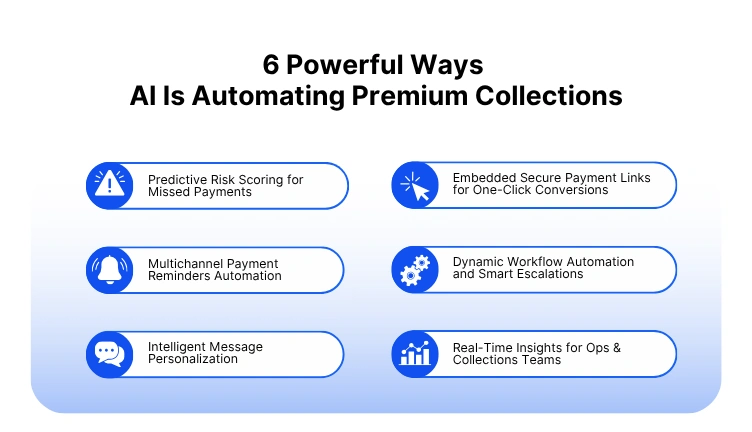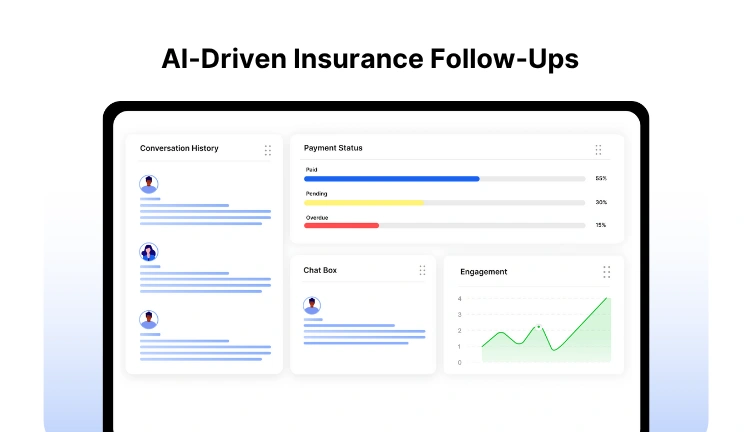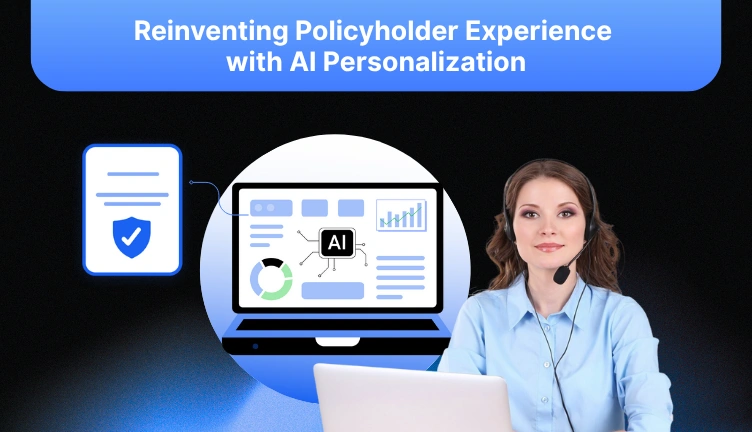Collecting premiums shouldn't feel like chasing ghosts. Yet, for many insurance companies, it still does.
Policy lapses, late renewals, and missed payments are frequent occurrences, and the manual labor required to recover them depletes resources like time and morale.
According to Brennan Clark, insurance debt collection is uniquely complex, often tangled in audits, overpayments, and inconsistent premium calculations. Add legacy systems and siloed customer data into the mix, and follow-ups become a black hole for ops teams.
A McKinsey report noted that insurance companies lose millions each year due to inefficiencies in collections, especially when reminders are one-size-fits-all or delayed. Without real-time data and personalization, even simple nudges fall flat.
Now, leading insurers are shifting to automated premium collection insurance models. AI manages it, scoring risk, sending follow-ups on the appropriate channel, providing one-click payments, and escalating only when necessary, in place of manual reminders and endless spreadsheets.
It’s not just about faster collections. It’s about freeing up teams, retaining more policyholders, and protecting revenue at scale. In this blog, we’ll unpack what’s broken with current collection models, how automation fixes it, and why the shift isn’t optional anymore.
Don’t lose revenue to delays. Automate now.
What Is Automated Premium Collection in Insurance?

Automated premium collection in insurance refers to the use of AI, machine learning, and digital payment solutions to manage and streamline the entire premium payment process without any manual intervention.
It eliminates the need for agents or back-office teams to chase policyholders for payments, helping insurance companies ensure timely payments and improve collection efficiency.
The Shift from Traditional Methods to Seamless Automation
In the traditional payment methods model, insurers rely heavily on emails, printed reminders, or manual follow-ups to collect insurance premiums.
These legacy systems are slow, error-prone, and expensive. Missed payments often lead to policy lapses, affecting customer retention and revenue.
With automated premium collections insurance, insurers use AI-driven workflows to:
- Send real-time payment reminders via email, SMS, WhatsApp, or voice bots.
- Offer personalized payment options, including UPI, debit card, credit card, or auto-debit from a bank account.
- Track payment patterns and respond with timely nudges before grace periods expire.
- Embed secure payment links directly in reminders for faster conversion.
Why It Matters for the Insurance Sector
Automating the premium collection process improves cash flow, reduces operational costs, and enhances the overall customer experience. Policyholders can choose a preferred payment method and opt for flexible payment options, such as recurring payments or one-time online payments.
This shift also helps insurance companies:
- Cut down on unpaid premiums
- Reduce dependency on legacy systems
- Scale operations without expanding headcount
- Maintain compliance and security measures around card details and customer data
Adopting insurance collections, AI, and automated payment solutions is now a competitive requirement in a sector where policy lapses and late payments have a direct impact on growth.
See how to make payments seamless, not stressful.
Why Premium Collection Is a Growing Pain for Insurers
Despite digital transformation across the insurance industry, many insurance companies still struggle with outdated, inefficient premium collection processes.
Delays in premium payments, an increase in policy lapses, and a decline in customer retention are all grave repercussions.
The Stakes Are Rising
The growing volume of digital product offerings and shorter payment cycles has increased pressure on collection teams. Customers expect fast, easy, and secure payment options, yet most insurers still rely on traditional payment methods that lack personalization or agility.
This gap between expectation and execution shows up in hard numbers:
- Rising rates of unpaid premiums due to inconsistent follow-ups
- Increased operational costs tied to manual outreach and fragmented systems
- Friction in the payment process leads to poor customer satisfaction
- Inability to track real-time payment patterns, causing revenue leaks
Manual processes, siloed tools, and a lack of automation also limit the ability to scale. Most insurers still rely on legacy systems for payment processing and reminders, which struggle to keep pace with today’s standards or policyholder expectations.
The outcome?
Slower cash flow, missed collection opportunities, and overburdened operations.
Insurance teams are reevaluating their collection processes, embracing new technologies like AI and payment reminder automation, as automation becomes a business necessity.
Premium lapses? Prevent them with AI.
6 Powerful Ways AI Is Automating Premium Collections

Premium collection directly affects revenue, customer satisfaction, and operational efficiency. Many insurance companies still rely on manual processes that slow down collections and frustrate customers.
Automation streamlines the entire premium payment journey by making it faster, smarter, and easier to manage. Below are the key benefits insurers gain by automating their collections.
1. Predictive Risk Scoring for Missed Payments
AI analyzes payment patterns, behavior signals, and engagement history to identify which policyholders are most likely to miss their insurance payments. This enables insurers to send timely reminders for payments to these groups in advance of the due date or grace period.
Result: Reduced late payments, fewer policy lapses, and higher collection efficiency.
2. Multichannel Payment Reminders Automation
Policyholders don’t all respond to the same nudge. Convin's artificial intelligence engine, which is activated by consumer behavior and preferred payment method, automates outreach via voice calls, email, SMS, and WhatsApp.
Result: Improved engagement and a higher rate of on-time premium payments without additional manual effort.
3. Intelligent Message Personalization
Generic messages don’t convert. AI personalizes reminders based on your current system's customer name, policy type, amount owed, and available payment methods. The result is hyper-relevant communication that increases action.
Result: Higher open and click-through rates on payment links, leading to more online payments.
4. Embedded Secure Payment Links for One-Click Conversions
Each reminder includes a secure, mobile-friendly payment gateway link tailored to the policyholder’s debit card, UPI, wallet, or bank account preferences. No app downloads or login barriers.
Result: Faster, smoother payment processing and increased conversion across all payment methods.
5. Dynamic Workflow Automation and Smart Escalations
Convin’s AI adapts in real time: if a payment isn’t completed after initial reminders, it automatically switches channels, changes tone, or escalates to a human agent, while complying with regulatory security measures.
Result: Lower operational costs and a massive cut in manual follow-ups.
6. Real-Time Insights for Ops & Collections Teams
AI captures live data on who paid, who didn’t, which channel worked best, and how to optimize the next cycle. This gives leadership a 360° view of cash flow, campaign performance, and customer behavior.
Result: Data-driven decisions to improve collection efficiency and forecast revenue more accurately.
Automated collections help insurers close payment gaps, reduce costs, and improve the customer experience. They create consistent results that can be tracked, measured, and improved over time.
Cut through delays with data-driven, AI-triggered reminders.
This blog is just the start.
Unlock the power of Convin’s AI with a live demo.

How Convin Powers AI-Driven Insurance Follow-Ups

Most insurance teams struggle with fragmented systems, delayed follow-ups, and low response rates. Convin solves these problems with AI-led automation designed specifically for the insurance industry.
It helps teams reduce manual work, speed up collections, and deliver a smoother experience to policyholders.
Here’s how Convin adds value across every step of the follow-up process:
1. Predicts and Prioritizes High-Risk Accounts
Convin identifies policyholders most likely to miss payments based on behavior, history, and engagement data. Teams can focus efforts where they matter most.
2. Automates Outreach Across Multiple Channels
Follow-ups are sent automatically based on customer behavior and timing via voice, WhatsApp, email, and SMS. No manual coordination needed.
3. Personalizes Every Interaction
Messages are tailored with policyholder details, premium amounts, and secure payment links. This increases response rates and accelerates payments.
4. Offers Seamless Payment Journeys
Each reminder includes one-click payment options. No additional procedures or logins are needed; customers can use UPI, cards, wallets, or their bank account.
5. Escalates Smartly When Needed
If a reminder is ignored, Convin adjusts the messaging or routes the case to a human agent. Follow-ups are persistent but compliant.
6. Integrates with Existing Systems
Convin plugs into your current CRM, policy system, or payment gateway with minimal setup. Your teams get results fast without disrupting daily operations.
Convin helps insurers take full control of their collections with intelligent, automated follow-ups that save time and protect revenue. Built for scale, speed, and customer retention, it transforms a reactive process into a proactive growth engine.
The Future of Collections Is Quietly Intelligent
A premium collection doesn’t need to be loud, manual, or chaotic. Insurance companies can stop chasing payments and start facilitating them with the correct automation, which can be done quietly, effectively, and on a large scale.
AI doesn’t just automate tasks; it brings clarity to who needs to be contacted, when, and how. It eliminates the guesswork and closes the loop on unpaid premiums with minimal disruption.
For insurers, this means more than better numbers. It means leaner operations, fewer policy lapses, and a better experience for both agents and policyholders. As more teams adopt AI-driven automation, the gap between traditional follow-ups and intelligent engagement will only grow.
If you're looking to move fast, reduce friction, and strengthen revenue retention, now is the time to act. Because even minor process changes have a big impact in the insurance collections industry, and those who are already adjusting are gaining ground.
Stop following up manually. Book a demo and automate with confidence.
FAQs
1. What payment methods can be used in automated premium collections?
Automated systems support UPI, debit cards, credit cards, wallets, and direct bank account transfers for seamless premium payments.
2. Is automated premium collection secure for customer data?
Most platforms follow strict security measures, including encryption and compliance protocols, to protect card details and transactions.
3. Can automation handle recurring payments in insurance?
Automation enables recurring payments to ensure timely insurance premium renewals without manual intervention.
4. How does AI help reduce grace period defaults?
AI detects payment patterns and sends timely, personalized payment reminders before the grace period ends to prevent policy lapses.
5. Can automated systems integrate with existing insurance CRMs?
Most AI-driven platforms are designed to plug into your existing system and streamline premium collections without disruption.







.avif)